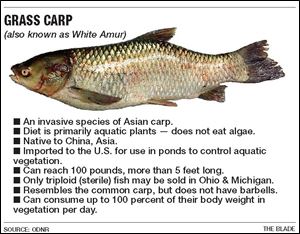
OUTDOORS
Sandusky River grass carp an alarming discovery
11/4/2013
Matt Markey
The Blade/Dave Zapotosky
Buy This Image

Matt Markey
SANDUSKY — The river the Shawnee called Potakihiipi has millions of fish in it. But the presence of four particular fish has sent a jolt through the ranks of biologists, fishermen, conservationists, and those who love the Sandusky River for every bit of its 130-mile loop through northern Ohio.
Four grass carp — an invasive species that poses a serious threat to native fish and the habitat used by waterfowl and other wildlife — were caught in the Sandusky late in 2012. That’s bad news.
An extensive analysis of these four Asian carp determined that they were not dumped in the river, flushed into the river, or present there as the result of migrating to the Sandusky.
These four fish were born there, providing the first confirmed case of any Asian carp species reproducing in the Great Lakes or its tributaries.
That’s really bad news.
“To me, if we don’t use this as a wakeup call and a rallying cry, then we are deaf to what Mother Nature is trying to tell us,” said Paul Pacholski, a Lake Erie charter captain with 30 years on the lake.
The scientific community has been warning us for years that the four invasive Asian carp species — grass carp, bighead carp, silver carp, and black carp — could potentially devastate the balance in the Great Lakes ecosystem by outbreeding and outfeeding native fish.

In certain sections of the Mississippi River system where Asian carp have been present for more than a decade after floods allowed them to escape from fish-rearing ponds, they now make up 80-90 percent of the fish in the waterway.
Grass carp were brought to this country as a biological alternative to using chemicals or manpower to control aquatic plants. Grass carp are raised on fish farms in several states around the U.S., but they must be treated and sterilized before they can be sold.
It is illegal to sell grass carp in Ohio or Michigan unless they are sterile.
But the quartet of grass carp pulled from the Sandusky River by a commercial fisherman were not the sterile, or triploid variety. Jeff Tyson, the Lake Erie program administrator for the Ohio Department of Natural Resources’ Division of Wildlife, said the source of these fish is a mystery that biologists are working feverishly to unravel.
“We still don’t have enough information on where they came from. The origin of these fish could go back to the 1980s, when diploid [fertile] fish were not illegal,” he said.
Tyson added that before any grass carp can be shipped to Ohio, the U.S. Fish & Wildlife Service conducts testing at the fish farms that produce the carp to determine if heat treatments intended to render the fish incapable of reproducing have been effective. He said Ohio will now ramp up its program of testing the fish once they get shipped to Ohio from the fish farms, which are primarily in Arkansas.
Grass carp have reproductive requirements similar to those of bighead and silver carp, so the presence of the young, fertile grass carp in the Sandusky seems to confirm the fear of biologists that invasive Asian carp will be able to propagate there.
“It certainly provides validation ... that Asian carp could live in shorter rivers like the Sandusky,” said Duane Chapman, a scientist with the U.S. Geological Survey who has led the research on Asian carp.
While bighead and silver carp are filter feeders that consume prodigious amounts of microscopic plankton, thus robbing a food source that is essential to native fishes, grass carp can destroy aquatic vegetation that provides critical habitat for other fish and wildlife, and food for waterfowl.
Pacholski, who has been active on the environmental front for the charter boat group, said he is frustrated by the lack of action by the federal government to address the Asian carp threat, which has been thoroughly documented for decades.
“These carp are coming, no doubt about it,” Pacholski said. “We can’t wait around for more studies or more hearings. We have to take action immediately.”
That sentiment was echoed hundreds of miles away, at the other end of the lake, where Toby Barrett, a member of Ontario’s provincial parliament from the Toronto area, put the shocking revelation of the presence of fertile, resident grass carp in the Lake Erie watershed in perspective.
“Billions and billions in tourism and fishery dollars are at stake,” Barrett said to the legislature. “We need action, not more environmental laws or strategies or panels or dithering.”
Great Lakes advocates have called for much tighter regulation of any transportation of Asian carp, enhanced inspection of grass carp that have been sterilized, more monitoring of bait shops and bait dealers who could be unknowingly transporting juvenile carp mixed with minnows, and a full closure of the Chicago Sanitary and Shipping Canal, which provides a man-made link between the Mississippi River watershed and Lake Michigan.
“The only real option is to close that canal,” Pacholski said. “As we’ve learned over and over on the Great Lakes, once an invasive fish gets in, you will never get it out.”
Contact Blade outdoors editor Matt Markey at: mmarkey@theblade.com or 419-724-6068.